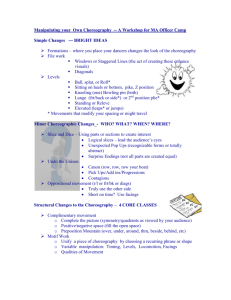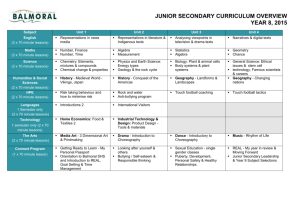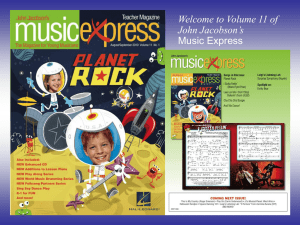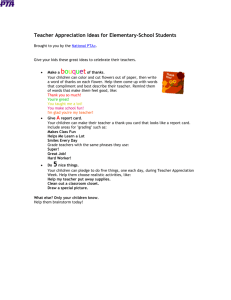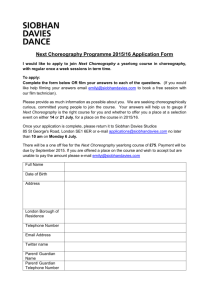Programme of Study and Success Criteria for Key Stage 3
advertisement
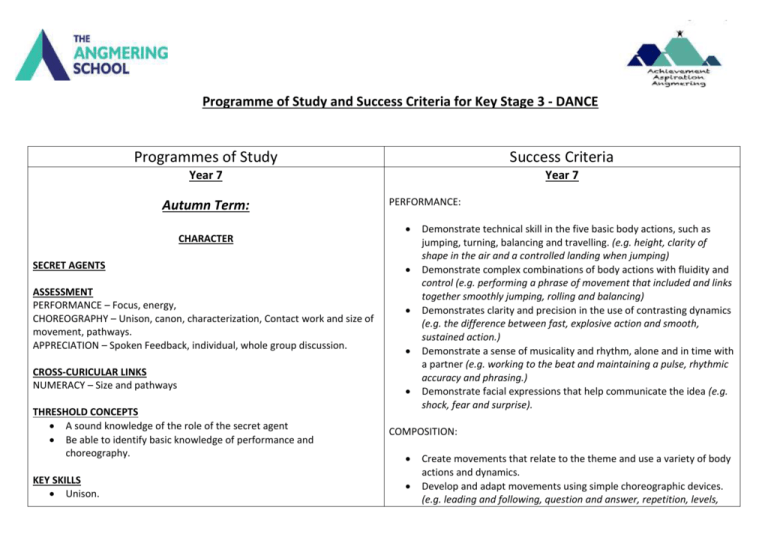
Programme of Study and Success Criteria for Key Stage 3 - DANCE Programmes of Study Success Criteria Year 7 Year 7 Autumn Term: CHARACTER SECRET AGENTS ASSESSMENT PERFORMANCE – Focus, energy, CHOREOGRAPHY – Unison, canon, characterization, Contact work and size of movement, pathways. APPRECIATION – Spoken Feedback, individual, whole group discussion. CROSS-CURICULAR LINKS NUMERACY – Size and pathways THRESHOLD CONCEPTS A sound knowledge of the role of the secret agent Be able to identify basic knowledge of performance and choreography. KEY SKILLS Unison. PERFORMANCE: Demonstrate technical skill in the five basic body actions, such as jumping, turning, balancing and travelling. (e.g. height, clarity of shape in the air and a controlled landing when jumping) Demonstrate complex combinations of body actions with fluidity and control (e.g. performing a phrase of movement that included and links together smoothly jumping, rolling and balancing) Demonstrates clarity and precision in the use of contrasting dynamics (e.g. the difference between fast, explosive action and smooth, sustained action.) Demonstrate a sense of musicality and rhythm, alone and in time with a partner (e.g. working to the beat and maintaining a pulse, rhythmic accuracy and phrasing.) Demonstrate facial expressions that help communicate the idea (e.g. shock, fear and surprise). COMPOSITION: Create movements that relate to the theme and use a variety of body actions and dynamics. Develop and adapt movements using simple choreographic devices. (e.g. leading and following, question and answer, repetition, levels, Gesture. Contact work Spring Term: CURRENT CHOREOGRAPHERS The Carman – Matthew Bourne ASSESSMENT PERFORMANCE – Timing CHOREOGRAPHY – Incorporation of props, levels APPRECIATION– Spoken Feedback, individual, whole group discussion. CROSS-CURICULAR LINKS NUMERACY – Levels THRESHOLD CONCEPTS An understanding of current and professional choregrapher. An ability to identify and use props in a successful way. KEY SKILLS Focus. Projection. Team work Summer Term: Cartoon Capers ASSESSMENT PERFORMANCE – Facial expression, dynamics. size, unison, canon, enlargement.) Create a narrative as a group. APPRECIATION: Identify key characteristics of performance and choreography that occur within the performance. Draw and describe key formations and pathways. Comment on the work of others, identifying strengths and areas of developments (e.g. acknowledging moments where characterisation is well expressed and highlighting moments that need further attention to dynamic clarity.) Set realistic targets for improvements. CHOREOGRAPHY – Adaptation of taught phrase. APPRECIATION– Spoken Feedback, individual, whole group discussion. CROSS-CURRICULAR LINKS THRESHOLD CONCEPTS To be able to perform with focus and character Be able to select appropriate movement to develop. KEY SKILLS Canon. Sensitivity to other performers. Accuracy of action. Year 8 Autumn Term Bootcamp ASSESSMENT PERFORMANCE – Focus, Precision, Energy, timing. CHOREOGRAPHY – Spatial formations, Unison, Canon. APPRECIATION– Spoken Feedback, individual, whole group discussion. CROSS-CURRICULAR LINKS NUMERACY – Sight lines, Angles, Spatial awareness. THRESHOLD CONCEPTS Be able to Perform set material in the style of bootcamp Be able to work as a team to choreography a strong and physical piece of choreography. KEY SKILLS Year 8 PERFORMANCE: Demonstrate technical skill in the five basic body actions, such as jumping, turning, balancing and travelling. (e.g. height, clarity of shape in the air and a controlled landing when jumping) Demonstrate energy, confidence and appropriate attitude. Demonstrate control and elegance in execution of movements. (e.g. control when landing from contact work or moving over and around other dancers) Demonstrate safe practice when in close proximity of other dancers. Demonstrate complex combinations of body actions with fluidity and control (e.g. performing a phrase of movement that included and links together smoothly jumping, rolling and balancing) Demonstrates clarity and precision in the use of contrasting dynamics (e.g. the difference between fast, explosive action and smooth, sustained action.) Demonstrate a sense of musicality and rhythm, alone and in time with a partner (e.g. working to the beat and maintaining a pulse, rhythmic accuracy and phrasing.) Focus, energy, projection, unison, canon, spatial formations. Spring Term CULTURAL INFLUENCES Tribes ASSESSMENT PERFORMANCE – Eye contact, projection, energy, dynamics CHOREOGRAPHY – Spatial Formation, canon, repetition. APPRECIATION– Spoken Feedback, individual, whole group discussion. CROSS CURRICULAR NUMERACY – Sight lines, Angles, Spatial awareness. THRESHOLD CONCEPTS Show energy and attempt to replicate authentic tribal movement. Perform with rhythm and energy. KEY SKILLS Unison Canon Repetition Team work COMPOSITION: CURRENT CHOREOGRAPHERS Rooster – Christopher Bruce ASSESSMENT PERFORMANCE – Energy, dynamics. Flow, transitions CHOREOGRAPHY – use of space, solo, group work, space, unison, canon. APPRECIATION– Spoken Feedback, individual, whole group discussion. Create movements that relate to the theme and use a variety of body actions and dynamics. (e.g. responding imaginatively to tasks.) Use a range of contact ideas to help communicate the narrative of work. (e.g. Lifting a partner, using a partner as a base and assisting partners flight) Develop and adapt movements using choreographic devices. (e.g. leading and following, question and answer, repetition, levels, size, unison, canon, enlargement.) Create a narrative as a group, using clear use of space to add variety and interest. APPRECIATION: Summer Term Demonstrate facial expressions that help communicate the idea (e.g. shock, fear and surprise). Identify key characteristics of performance and choreography that occur within the performance. Draw and describe key formations and pathways. Comment on the work of others, identifying strengths and areas of developments (e.g. acknowledging moments where characterisation is well expressed and highlighting moments that need further attention to dynamic clarity.) Set realistic targets for improvements. CROSS-CURRICULAR LINKS NUMERACY – Sight lines, Angles, Spatial awareness. THRESHOLD CONCEPTS Be able to perform rep from professional work and develop into a trio. KEY SKILLS Unison Canon Accurate reproduction of movement. Year 9 Autumn Term MODERN, MULTI-CULTURAL BRITAIN Year 9 PERFORMANCE: Urban Playground/ Culture ASSESSMENT PERFORMANCE – Focus, Energy, Dynamics CHOREOGRAPHY – Levels, Pathways, Contact work, Group formations. APPRECIATION– Spoken Feedback, individual, whole group discussion. CROSS CURRICULAR Link to other art forms – paintings, songs etc NUMERACY – Sight lines, Angles, Spatial awareness. ART, DESIGN & TECHNOLOGY – Costume, prop design/making THRESHOLD CONCEPTS Demonstrate good co-ordination of technical skill in the five basic body actions, such as jumping, turning, balancing and travelling. (e.g. height, clarity of shape in the air and a controlled landing when jumping) Demonstrate energy, confidence and appropriate attitude when performing, showing ability to remember motifs. Demonstrate control and elegance in execution of movements. (e.g. control when landing from contact work or moving over and around other dancers) Demonstrate safe practice when in close proximity of other dancers. Demonstrate complex combinations of body actions with fluidity and control (e.g. performing a phrase of movement that included and links together smoothly jumping, rolling and balancing) Demonstrates clarity and precision in the use of contrasting dynamics. Allow the work to be rich in contrasting dynamics, building to a climax to enhance communication of the dance idea. (e.g. the difference between fast, explosive action and smooth, sustained action.) to be able to make connections between art forms and culture KEY SKILLS Characterisation Accuracy Dynamic Contrast COMPOSITION: Spring Term Facebook ASSESSMENT PERFORMANCE – Energy, Focus, dynamics. CHOREOGRAPHY – Development of gesture. APPRECIATION– Spoken Feedback, individual, whole group discussion. CROSS CURRICULAR Link to popular culture THRESHOLD CONCEPTS to be able to work together to create their own piece of choreography KEY SKILLS Unison Contact work Control CROSS - CURRICULAR Create movements that relate to the theme and use a variety of body actions and dynamics. (e.g. responding imaginatively to tasks.) Use a range of contact ideas to help communicate the narrative of work. Use manipulation and contact improvisation to develop contact work. (e.g. Lifting a partner, using a partner as a base and assisting partners flight) Develop and adapt movements using choreographic devices. (e.g. leading and following, question and answer, repetition, levels, size, unison, canon, enlargement.) Create a narrative as a group, using clear use of space to add variety and interest. APPRECIATION: Summer Term Numeracy Demonstrate a sense of musicality and rhythm, alone and in time with a partner (e.g. working to the beat and maintaining a pulse, rhythmic accuracy and phrasing.) Demonstrate facial expressions that help communicate the idea (e.g. shock, fear and surprise). Identify key characteristics of performance and choreography that occur within the performance. Showing the understanding of key roles, i.e. choreographer and performer. Identify the choreographer of influences of the piece. Draw and describe key formations and pathways performed, commenting of choreographic journey the group have developed. Comment on the work of others, identifying strengths and areas of developments (e.g. acknowledging moments where characterisation is well expressed and highlighting moments that need further attention to dynamic clarity.) Set realistic targets for improvements. ASSESSMENT PERFORMANCE – Focus, energy, dynamics, CHOREOGRAPHY – Accurate reproduction of movement. Re-ordering of movement. APPRECIATION– Spoken Feedback, individual, whole group discussion. CROSS CURRICULAR NUMERACY THRESHOLD CONCEPTS Links to numeracy. KEY SKILLS Projection Sensitivity to other performers Entrances and exits
